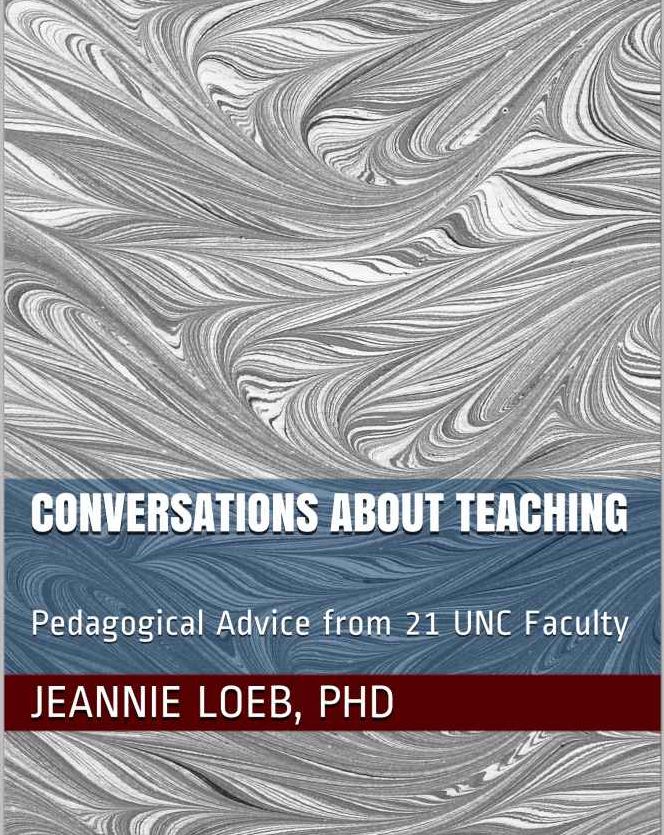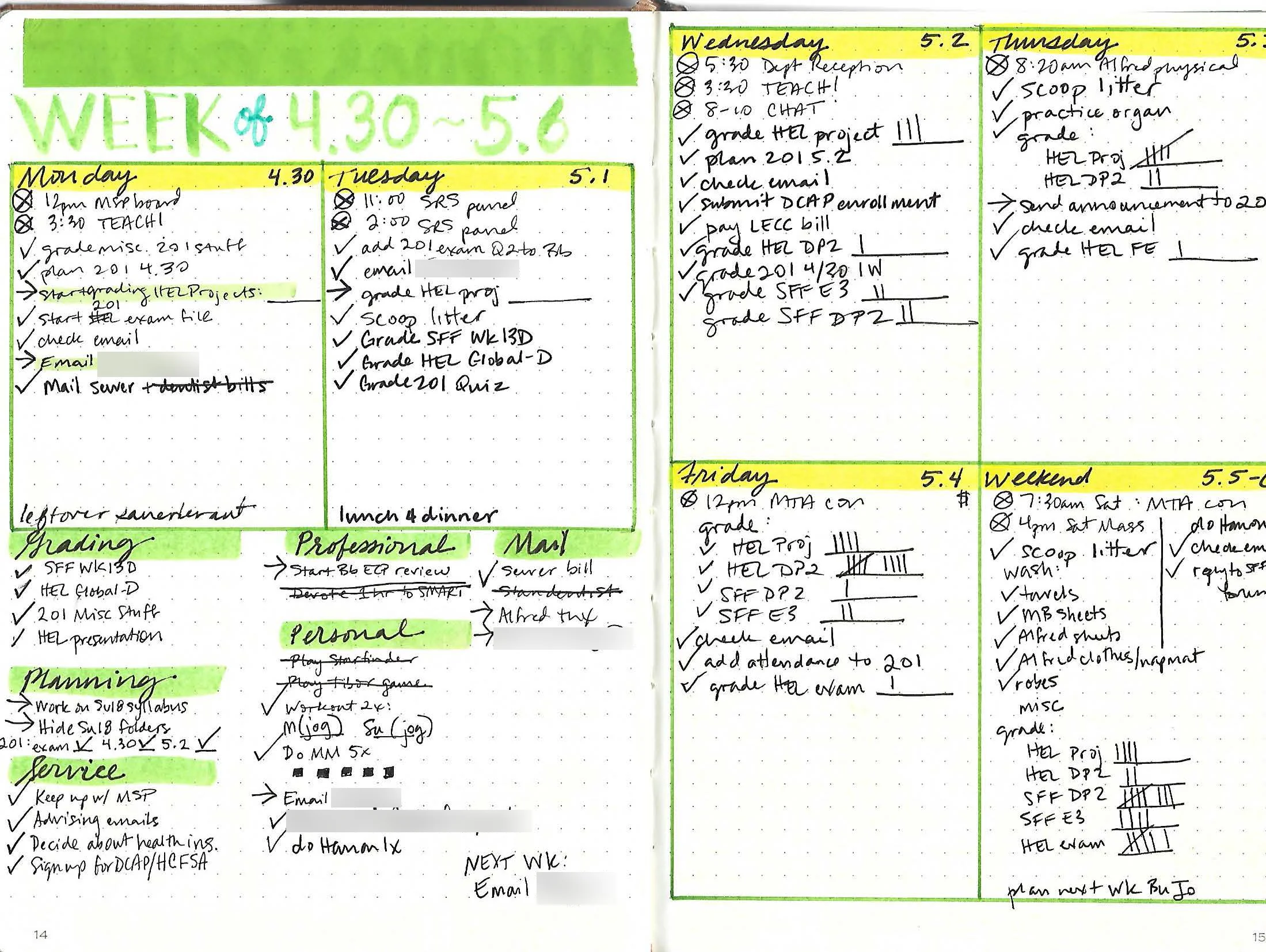How One Academic Professional Uses Bullet Journal to Stay Organized
If you’re into productivity, you might have heard of the Bullet Journal system, which is pen-and-paper method of managing schedules, projects, ideas, and task lists. In this post, I’m going to talk about how my own Bullet Journal (often abbreviated BuJo) fits into my professional workflow as a teacher. There are oodles of talented people sharing their BuJo journeys out there on the Internet, but I thought it might be interesting to share the perspective of an academic whose work is primarily digital and less rigidly structured than a typical 8-5 job.
At its core, Bullet Journal is a relatively simple, no-frills way of using a notebook to track to-do lists and “collections” of related concepts. If BuJo is new to you, check out this quick introductory video. As you can see in the video, the basic BuJo is quite straightforward. Black text on white paper, simple symbols indicating whether a task is completed, partially completed, or “migrated” (i.e. moved forward to a future day). It’s an easy-to-use way of organizing whatever’s going on in your life.
Many people have embellished the basic BuJo structure with additional “spreads,” decorative elements, “trackers” for everything from habits to moods to phases of the moon, and more. There’s a fascinating genre of blogs, Instagram accounts, and YouTube channels devoted entirely to sharing planner tips, a genre that seems to be inhabited primarily by entrepreneurial women with meticulous handwriting who are armed with an arsenal of washi tape, artist pens, and Leuchtturm1917 notebooks. I enjoy looking at beautiful, inspirational photos and videos by BuJo pros like BohoBerry, Sunshine & Stationery, Tiny Ray of Sunshine, and others, although my own journal is much less elaborate than many.
Without further ado, here are some illustrations of how I use the system.
My Bullet Journal: Illustrated





I’ve been Bullet Journaling since August 2014, and I’m on my fourth notebook. Like many enthusiasts, I prefer the Leuchtturm1917 dotted in A5 size.
My Monthly Spread
The basic BuJo uses a vertical list of dates for monthly planning. I’ve found that I like a 2-page setup, with a calendar drawn on one page and a list of goals on the other. My actual day-to-day schedule of appointments “lives” in my Google Calendar, and I don’t necessarily transfer everything from GCal to the paper journal. Nevertheless, seeing the visual layout of the month helps me to envision the scope of what’s going on, and how professional and personal events fit together.
In the March 2017 spread pictured in this post, I used the calendar for tracking habits and also for seeing what the ebb and flow of work would be. For instance, the assignment due dates for my classes are highlighted in pink, which lets me know that after that day, I’ll have a batch of assignments to grade.
During the semester, I often use the monthly goals page to note all of the teaching tasks that I’ll need to get done. This month is typical of a busy time in the semester, in that most of the teaching-related tasks were complete, while many of the personal tasks fell by the wayside!
My Weekly Spread
A weekly spread isn’t part of the original BuJo system, but like many people, I’ve found it helpful to add one. For me, in particular, my life is divided into weeks. In the online courses that I teach, a week is the primary unit of the class: content is released weekly (every Monday at 12:00am) and student assignments are due weekly. For an academic, and especially an academic specialist in digital pedagogy, a weekly spread is essential.
In my weekly spread, I’ll often break down a larger item from the monthly spread into more granular tasks. For example, a monthly item might be something like “Plan Spenser & Milton Week 14.” That’s really a project, not a task, because there’s a lot that goes into planning a single week of a course. In my weekly spread, I’ll break the project down into items like the ones you see on this sample, which include re-reading the course texts, creating my lecture, creating assignments, and loading the content into Blackboard. Even some of these items could be broken down further, and in my daily spreads I’ll often do just that.
Each week on Sunday, I create my list for the next week, which I find to be a kind of meditative activity in which I try to think of all the things that need to get done in order to keep my work on track, both for immediate projects (e.g. courses that I’m teaching right now) and future projects (e.g. upcoming courses or personal projects).
My Daily Spread
Finally, there’s the heart of the BuJo system, the daily list. I've shared two examples in the gallery above. For a long time, I used the basic signifier of an “X” to cross off a completed task, but lately I’ve moved to a check-mark, because somehow it feels like a more positive gesture to make a check when something’s done. In one of the examples here, I was color-coding tasks, which is something that I’ve experimented with on-and-off.
As a teacher, one thing that I like about BuJo is that I keep it beside me throughout the day and use it to stay motivated by making small progress toward larger goals. So, for instance, the May 1 and May 2 entries are from the “grading frenzy” after classes ended, and I sometimes use my daily list to mark off the number of items of a particular assignment that I’ve graded.
Overview
I would be remiss if I didn’t offer some caveats and drawbacks. First of all, I paradoxically find it much easier to be productive when I’m busier. The more things I have to do, the more I’ll get done. It’s no coincidence that the spreads I chose to share in this essay are from very busy times of the semester, in no small part because it would be embarrassing to share a daily spread in which nothing’s checked off and everything’s migrated to the next day! Thus, I also find it easier to use my BuJo for keeping track of immediate tasks and short term projects: grading a single essay, planning a single week of a class, doing a single small project for a committee. Even after almost three years of using this system, I still think I could improve at how I use BuJo to plan larger, long-term projects.
Overall, my Bullet Journal has been an essential part of my daily planning for years now. For a teacher and a higher-ed professional, one feature that I love about BuJo is its adaptability. If a particular detail or spread doesn’t work for you, you can easily change it, and it’s also easy to add and subtract new elements as needed. If anyone wants to know more about how I use the Bullet Journal system, please ask in the comments!





